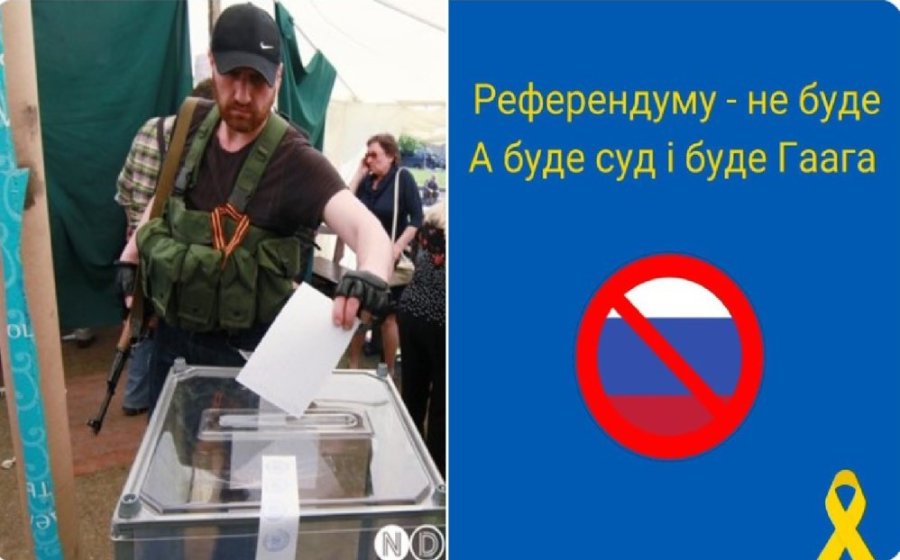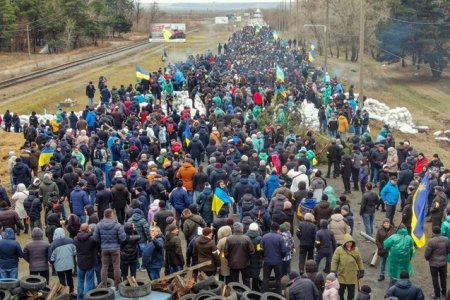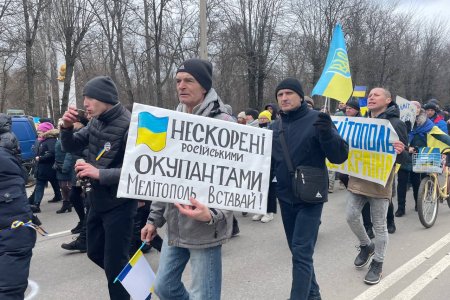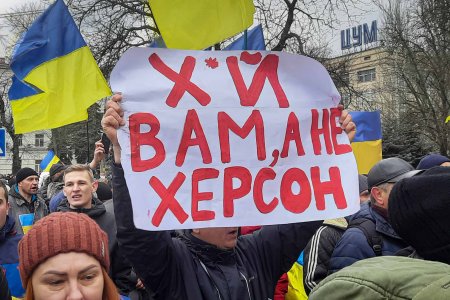
Russia’s ruling party is using fake ‘help centres’ in parts of Ukraine seized by the Russian army to facilitate the rigging of pseudo ‘referendums’ on Russian annexation of further Ukrainian territory. News of Donbas quotes Russian political analyst Igor Yakovenko as suggesting that Moscow is in a hurry to stage such events now so that it can then claim that the Ukrainian Armed Forces’ counter-offensive against the invaders is ‘an attack on Russian territory’.
There has been talk of such fake referendums since Russia seized control of parts of the Zaporizhzhia and Kherson oblasts in March 2022, and the fact that Russia did not try such a stunt earlier is probably because they had huge difficulty in finding Ukrainians willing to collaborate with them. This is likely the reason for ‘United Russia’s’ involvement and the cynical use of supposed humanitarian aid as a method of obtaining names and other personal data of people still present in the area. Russia has vast experience of rigging ‘elections’, both at home and on occupied Ukrainian territory, and does not need much more than such data to fabricate a ‘referendum’.
Russian leader Vladimir Putin began artificially pumping up the number of ‘Russian citizens’ in ‘D-LPR’ in April 2019 with his first decree on simplifying procedure for receiving Russian citizenship. This was later extended to all Ukrainians living in the Donbas region. Both moves were condemned by the international community, but did not, unfortunately, result in increased sanctions. By 2021, the United Russia party was actively expanding its presence in occupied parts of Donbas, and openly admitting Russia’s intention to annex the whole area. In the summer of 2021, Russia’s election commission issued a decision, ‘allowing’ Ukrainians from such territory, who had received Russian passports, to vote in the Russian parliamentary elections. Interest in doing so was extremely limited, and Russia typically resorted both to deceit and to coercion. Public sector workers were effectively forced into travelling by buses to Rostov in order to ‘vote’, while people in occupied Donbas were encouraged to receive a Russian SNILS [an Individual Insurance Account Number]. The propaganda campaign clearly suggested that Donbas residents would then be entitled to Russian social benefits, although the real reason was simply in order to make it possible for them to (be forced to) vote online. Similar deceit is now being used to obtain personal data under the guise of ‘United Russia’s aid centres’.
No date has yet been formally given for the aggressor state’s attempt to fake a referendum, however 11 September has been mentioned many times over recent months. Although the information about supposed ‘preparations’ is now coming from occupation regimes and collaborators, Yakovenko points out that very little is, in fact, needed. As he says, “No particular preparation is needed to hold a referendum there. We know well how the president’s administration is able to carry out voting. One or two people are sufficient to create a picture of how residents are voting. At the end of the day, they will show a protocol in which it’s written that all 98% of those living in the Kherson oblast voted to join Russia.”
News of Donbas’ sources say that in occupied parts of the Luhansk oblast, ‘preparations for a so-called referendum’ are underway even in very small populated areas, with the claim being that almost 500 ‘polling stations’ will be opened. The supposed creation of election commissions and preparation of polling stations are all essentially for show, News of Donbas stresses, in order to try to legitimize this so-called ‘referendum’. The so-called ‘ballot papers’ were generated on an ordinary photocopier; anybody could ‘vote’, with or without identification and proof that they lived in the area, and could do many times. Russia stopped short of formally recognizing either that absurd travesty, or the ‘elections’ staged late that year. That, however, has not stopped either Russia’s state-controlled media or, of course, the Russian-installed ‘republic leaders’ from pretending that the earlier event marked the ‘democratically expressed wish of the people’ for the creation of these fake ‘republics’.
As reported, the invaders are now actively imitating ‘referendum preparations’ in recently seized parts of the Donetsk oblast, including Mariupol, the Zaporizhzhia and Kherson oblasts. Nor are they solely relying upon the data tricked out of people by United Russia, which has 31 ‘help centres’ in seized parts of the Donbas; Kharkiv; Kherson and Zaporizhzhia oblasts. In the Kherson oblast, the police reported at the end of June that the Russians had stolen documents, including voter lists, from the Kherson Regional State Archive. According to Pavlo Lisiansky, from the Institute of Strategic Research, Russian MPs from ‘United Russia’ have also been sent to the area, with at least one quoted as asserting that the local population ‘welcome’ the Russian army. If that had been the case, News of Donbas notes, Moscow would surely have been in a hurry to organize a ‘referendum’, and this has certainly not been the case.
If that were the case now, the invaders would not be abducting so many Ukrainians from seized territory; and would not be forcibly extracting personal data from residents who clearly want nothing to do with any ‘vote’.
As with the attempts made to legitimize their invasion and occupation in 2014, any ‘referendum’ now is entirely illegal. Russia’s use of its own ruling party vividly demonstrates how little support it has found among the population of invaded and seized Ukrainian territory. Ukraine’s Constitution and legislation are quite clear how any referendum must be prepared and carried out, and who can initiate it. There is also clarity as to when it is impossible to hold any referendum, and this includes during a war. Russia can use any euphemisms it likes, but it will remain an invading and occupying state, whose ‘referendum’ farce will be at gunpoint and of zero validity.



